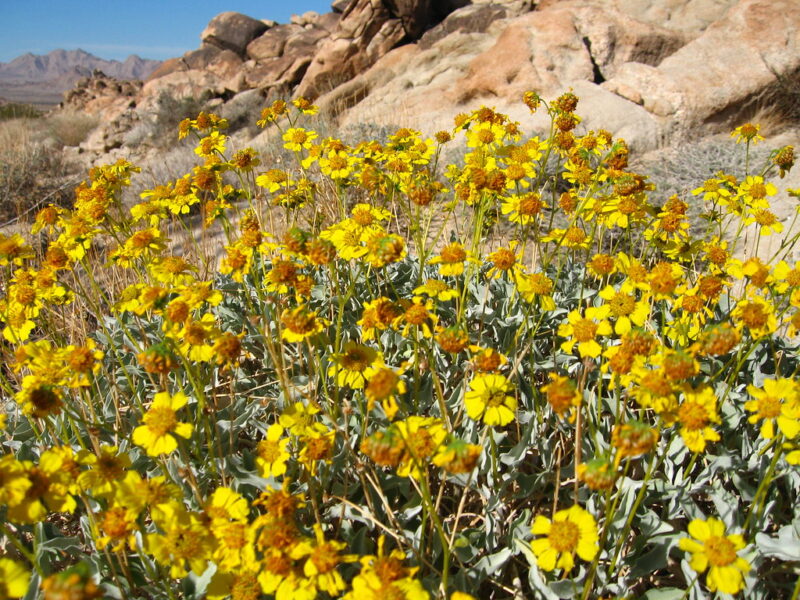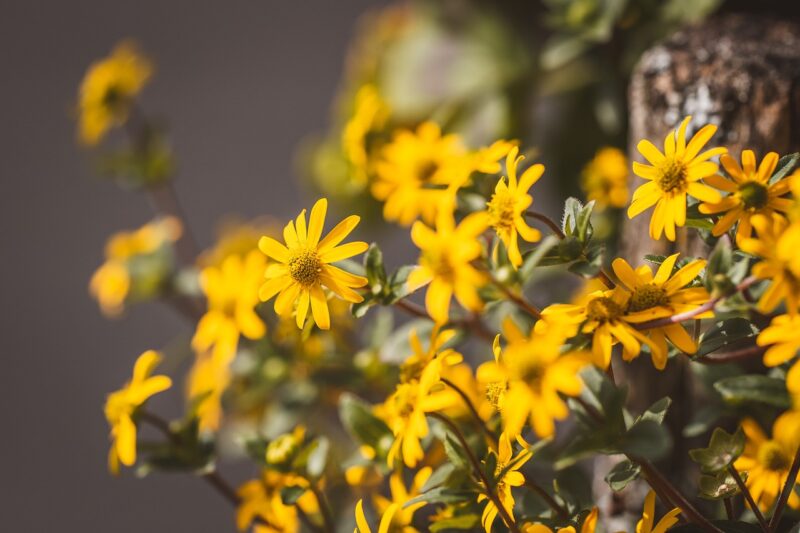The high desert offers unique environmental challenges, including extreme temperatures, aridity, and intense sun exposure. However, it’s also home to a rich array of flora that have adapted to thrive in these conditions.
Whether you’re looking to beautify your garden or create a sustainable landscape, choosing the right plants is essential. This post explores a selection of effective plants suited for high desert environments, highlighting their characteristics and benefits.
Acacia greggii (Catclaw Acacia)

Acacia greggii, or Catclaw Acacia, is a remarkable choice for anyone looking to create an attractive barrier plant in their high desert garden. Reaching heights and widths of 10-15 feet, this shrub is known for its thorny branches that deter unwanted intruders while providing a lush green appearance. Its bright yellow fluffy flowers in spring not only add a vibrant touch to the landscape but also attract beneficial pollinators like bees. The Catclaw Acacia is highly drought-tolerant once established, making it an ideal companion for low-water gardens.
Betula occidentalis (Western Waterbirch)

For a more ornamental addition, consider Betula occidentalis, or Western Waterbirch. This tree, which typically grows to about 15 feet high and 10 feet wide, features a unique weeping habit and striking copper-colored bark that peels away to reveal a lighter hue underneath. The Western Waterbirch thrives near seasonal water sources, making it a great choice for those who can provide periodic moisture. Its delicate foliage offers a refreshing shade in the summer months and a lovely display of golden-yellow color in the fall, bringing a touch of seasonal beauty to the high desert.
Calocedrus decurrens (Incense Cedar)

The majestic Calocedrus decurrens, or Incense Cedar, is a towering evergreen that can reach heights of 70-90 feet and widths of 20 feet. This large, aromatic tree is not only visually impactful but also contributes to the diversity of the landscape. Its distinct, feathery foliage releases a pleasant scent when crushed, adding an aromatic quality to your outdoor space. The Incense Cedar prefers well-drained soils and is ideal for larger properties in the high desert, where its impressive size can provide shade, habitat, and beauty for years to come.
Cercidium floridum and Cercidium microphyllum (Palo Verde)

Colorful and resilient, the Palo Verde trees, both Cercidium floridum and Cercidium microphyllum, are quintessential desert trees that grow between 20 to 30 feet high and wide. Famous for their beautifully green stems and bright yellow flowers that bloom in the spring, these trees embody the spirit of the desert. The Palo Verde is particularly drought-tolerant, perfectly suited to hot climates where other species might struggle. Its umbrella-like canopy provides filtered shade, making it an excellent option for creating inviting outdoor spaces.
Cercis occidentalis (Western Redbud)

The Western Redbud, or Cercis occidentalis, is a small multi-trunked tree that reaches around 15 feet high and 10 feet wide. Known for its stunning pink to purple flowers that bloom in early spring before the leaves emerge, this tree is a showstopper in any garden. Its ability to thrive in partial shade makes it a versatile choice for transitional areas within your landscape. The Western Redbud’s heart-shaped leaves turn a brilliant yellow in the fall, providing an extended season of interest, making it a delightful addition to high desert gardens.
Chilopsis linearis (Desert Willow)
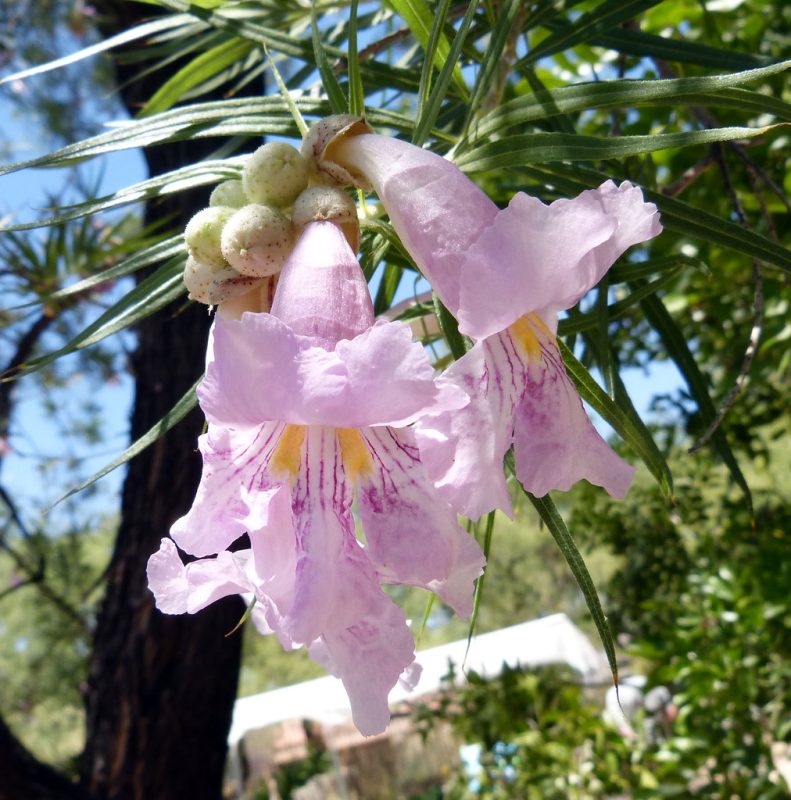
The Desert Willow, or Chilopsis linearis, is a vibrant summer-blooming tree that can grow 20 feet tall and about 15 feet wide. This deciduous tree features long, narrow leaves and produces lovely trumpet-shaped flowers that range in color from white to pink and lavender. The blooms emerge in large clusters during the summer months, attracting hummingbirds and butterflies, thus enhancing the biodiversity of your garden. The Desert Willow is exceptionally drought-tolerant and is perfect for creating a colorful oasis within the arid desert landscape.
Cupressus arizonica ssp. nevadensis and C. forbesii (Cypress Species)

For those seeking evergreen options, the native cypress species, such as Cupressus arizonica ssp. nevadensis (Arizona Cypress) and C. forbesii (Tecate Cypress), serve as exceptional choices for the high desert. These cypress trees vary in size, but generally, they can provide dense foliage and structure to landscapes. Arizona Cypress, for example, can reach up to 30 feet high, offering an attractive, drought-resistant alternative for windbreaks or visual barriers. Their aromatic foliage also adds a sensory layer to your outdoor space, creating a serene garden environment.
Juglans californica var. californica (Black Walnut)

The Black Walnut, or Juglans californica var. californica, is a deciduous tree that typically grows 20 feet high with a width of 5 to 10 feet. This drought-tolerant tree provides valuable shade and beautiful foliage that turns golden-yellow in the fall. The Black Walnut is particularly renowned for its rich wood and, interestingly, the walnuts it produces can attract various wildlife. Planting this tree not only enhances your garden’s diversity but also contributes positively to local ecology by supporting various animal species.
Juniperus californica (California Juniper)
Juniperus californica, or California Juniper, offers a highly variable form, reaching from 5 to 25 feet in height and 3 to 10 feet in width. This slow-growing tree is ideal for those looking to create natural, rustic landscapes. Its dense foliage provides dense cover for small wildlife and lends itself well to bonsai cultivation due to its manageable size and form. The California Juniper’s deep root system allows it to survive in extremely dry conditions, making it suitable for gardeners aiming to minimize water usage.
Pine Species (Pinus coulteri, Pinus jeffreyi, Pinus monophylla, Pinus ponderosa)

A selection of pine species, including Pinus coulteri, Pinus jeffreyi, Pinus monophylla, and Pinus ponderosa, bring both aesthetic appeal and practical benefits to high desert gardens. These tall, evergreen trees range in size but can stand impressively tall, providing shade and creating a vertical element in landscapes. They are well-adapted to withstand arid conditions and produce soft, needle-like leaves that make for lush greenery even in the driest months. Pines are not only beneficial for shade but also contribute to carbon capture and wildlife habitat.
Populus fremontii (Cottonwood)

The Fremont Cottonwood, or Populus fremontii, is an expansive tree that can reach 60 feet in height and 20 feet in width. Known for its striking beauty, it features a broad, rounded crown and produces stunning fall colors. However, it requires regular water, making it suitable for areas with more moisture availability. The Cottonwood’s majestic stature and lush foliage provide cooling shade, making it an inviting choice for creating serene garden retreats in the high desert.
Prosopis pubescens (Screwbean Mesquite)

Screwbean Mesquite, or Prosopis pubescens, stands out as an attractive desert tree that grows between 10 to 25 feet high and spreads about 20 feet wide. Its unique, twisted seed pods and small, yellow flowers attract wildlife while providing food for birds and insects. This tree exhibits excellent drought tolerance and helps fix nitrogen in the soil, enriching the garden ecosystem. The Screwbean Mesquite’s inviting form and impressive foliage make it an ideal choice for any sustainable garden design in the high desert.
Oak Species (Quercus engelmannii, Quercus chrysolepis, Quercus kelloggii, Quercus douglasii)

Several oak species, including Quercus engelmannii, Quercus chrysolepis, Quercus kelloggii, and Quercus douglasii, add diversity and resilience to high desert gardens. Depending on the species, these oaks range from moderate to large in size, with their broad canopies providing shade and shelter to various wildlife. Oaks are slow-growing but long-lived, contributing to the ecological health of the region by supporting diverse wildlife. Their hardy nature and adaptability to a range of soil conditions make them invaluable as foundational trees in any desert landscape.
Umbellularia californica (California Bay Laurel)

Last but certainly not least, the California Bay Laurel, or Umbellularia californica, is a stunning aromatic tree that can grow up to 75 feet tall and 60 feet wide. This tree is well-known for its leaves that have culinary applications, adding flavor to dishes. Its dense canopy creates a delightful shaded area beneath, making it an ideal tree for garden spots intended for relaxation and leisure. As a native to California, the Bay Laurel thrives in well-drained soils and offers year-round greenery, making it a fantastic choice for high desert planting.
Adenostoma fasciculatum (Chamise)

Adenostoma fasciculatum, commonly known as Chamise, is a remarkable evergreen shrub that typically grows between 2 to 10 feet high and can spread up to 10 feet wide. This chaparral native is characterized by its dense, bushy structure and slender, needle-like leaves. Chamise is known for its ability to thrive in poor soil conditions and is excellent for erosion control, making it a popular choice for slopes and challenging terrains. Its flowers, although discreet, attract beneficial insects, and its resilience to drought conditions makes it a smart addition to any high desert landscape.
Amelanchier alnifolia (Western Serviceberry)

The Western Serviceberry, or Amelanchier alnifolia, is a deciduous shrub that offers a variety of seasonal highlights, growing between 2 to 15 feet high and 8 feet wide. In spring, it bursts forth with delicate white flowers, which mature into small, edible berries that are favored by both wildlife and humans. Its beautiful fall foliage showcases stunning shades of orange and red, enriching the landscape. This versatile shrub is ideal for creating a dynamic garden that thrives in well-drained soils typical of the high desert.
Arctostaphylos glauca (Bigberry Manzanita)

Arctostaphylos glauca, or Bigberry Manzanita, is a standout addition to any high desert landscape, reaching heights of approximately 12 feet and spreading about the same. This evergreen shrub is best known for its striking red-brown bark, which beautifully contrasts its green leaves. The Bigberry Manzanita produces small, urn-shaped flowers that attract pollinators, including bees and hummingbirds. This species is drought-tolerant and thrives in rocky, well-drained soils, making it a great choice for low-maintenance gardens that celebrate the desert’s natural beauty.
Artemisia tridentata (Great Basin Sagebrush)

Artemisia tridentata, or Great Basin Sagebrush, is a fragrant desert-native shrub that grows up to 4 feet high and wide. This iconic sagebrush is recognized for its attractive grey foliage and distinctive silvery appearance, adding a soft texture to desert gardens. It plays an important role in the local ecosystem, providing habitat and food for many species of wildlife. Moreover, its aromatic leaves are known for their therapeutic properties and are an important part of Indigenous medicinal practices, making it both a beautiful and culturally significant choice.
Atriplex spp. (Saltbush)

The Saltbush genus, Atriplex spp., encompasses various species adept at thriving in arid desert conditions. Ranging in size, these shrubs provide essential habitat for wild birds and other wildlife. Saltbush is particularly valuable for its high salt tolerance, making it suitable for saline soils often found in desert areas. Their intricate foliage and unique textures introduce a distinct charm to the landscape, while requiring very little water once established, thus enhancing the sustainability of any high desert garden.
Calliandra californica and Calliandra eriophylla (Fairyduster)

Fairyduster, comprising species like Calliandra californica and Calliandra eriophylla, reaches heights of 3 to 5 feet and spreads similarly. This delightful shrub produces colorful red or pink blossoms year-round, creating a stunning visual display in the garden. It’s also a favorite among pollinators, attracting bees and butterflies, which adds life and activity to your outdoor space. Their ability to tolerate drought and thrive in poor soils makes Fairyduster an excellent ornamental plant for low-water gardens.
Ceanothus greggii (Mojave Ceanothus)

Mojave Ceanothus, known scientifically as Ceanothus greggii, is a beautiful drought-tolerant shrub that typically grows 4 to 6 feet tall and wide. In spring, it showcases an abundance of stunning white flowers that are not only attractive but also beneficial to local pollinators. This evergreen species is excellent for providing natural habitat and is often utilized in erosion control projects due to its extensive root system that stabilizes the soil. Its adaptability to minimal irrigation makes it a superb choice for sustainable gardening in the high desert.
Cercocarpus ledifolius (Mtn Mahogany)

Cercocarpus ledifolius, or Mountain Mahogany, is a remarkable shrub or small tree that can grow up to 30 feet high and spread up to 15 feet wide. This native plant is appreciated for its distinctive plumed seeds that add visual interest during the summer months. Its thick, leathery leaves provide excellent drought resistance, making it well-suited for arid environments. Mountain Mahogany is often used as a windbreak or screen, providing shelter to various animals and contributing to the overall biodiversity of the area.
Chrysothamnus nauseosus (Rubber Rabbitbrush)
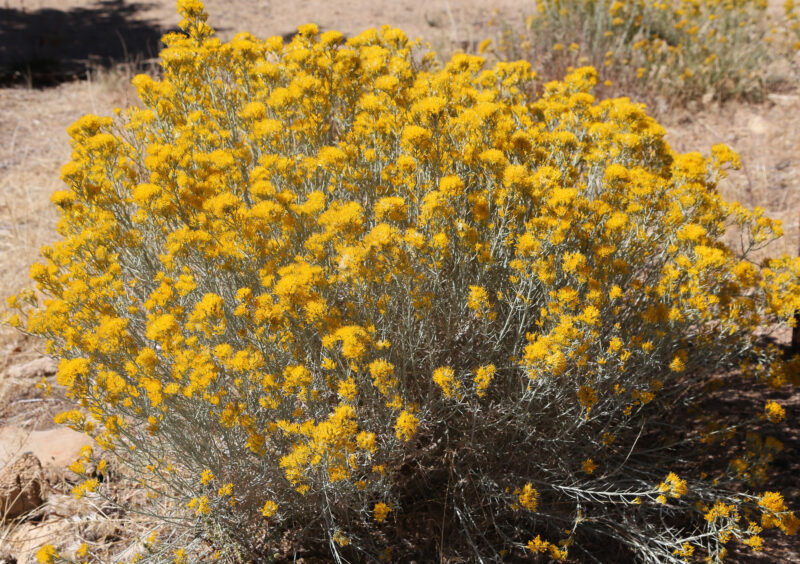
Chrysothamnus nauseosus, or Rubber Rabbitbrush, is a delightful desert native that reaches heights of 2 to 4 feet and spreads around 3 feet wide. This resilient shrub is known for its bright yellow flowers that bloom in the late summer and early fall, attracting a variety of butterflies and pollinators. Its aromatic foliage adds another layer of sensory appeal, while its tolerance to dry conditions makes it a staple in desert landscaping. The presence of Rubber Rabbitbrush can help support local ecosystems, making it a desirable addition.
Dendromecon rigida (Tree Poppy)

Dendromecon rigida, commonly referred to as Tree Poppy, reaches heights of 8 feet and can spread 6 feet wide. This deciduous shrub stands out with its unique blue-green leaves complemented by bright yellow flowers that bloom in the spring. Its vibrant flowers create a stunning contrast with its foliage and are known to attract pollinators. Tree Poppy thrives in full sun and well-drained soils, making it particularly suited for high desert gardens. Its drought-tolerant nature ensures it remains a beautiful and low-maintenance choice for any gardener.
Encelia actoni (Acton Encelia)
The Acton Encelia, or Encelia actoni, is a charming low-growing shrub that typically reaches 2 feet in height and 3 feet in spread. It is characterized by its vibrant yellow, daisy-like flowers that bloom in the spring, attracting essential pollinators and bringing a splash of color to the landscape. In addition to its ornamental value, this shrub’s ability to thrive in dry, rocky soils makes it perfect for water-efficient gardens, embodying the hardy spirit of high desert flora.
Encelia farinosa (Brittlebush)

Encelia farinosa, commonly known as Brittlebush, grows to about 3 feet high and 4 feet wide. Its striking white foliage contrasts beautifully with other desert plants, and it produces bright yellow flowers in the spring. Brittlebush is highly drought-resistant and thrives in sunny locations, making it a resilient option for the high desert. Its succulent nature allows it to store water effectively, ensuring that it can withstand the harsh summer conditions while providing essential ground cover and habitat for small animals.
Eriodictyon trichocalyx (Yerba Santa)

Yerba Santa, or Eriodictyon trichocalyx, is a significant shrub known for its medicinal properties and cultural relevance. This plant reaches up to 4 feet in height and width, showcasing glossy, green leaves and small, tubular flowers that bloom in the spring. Yerba Santa’s leaves contain essential oils that have been used by Native Americans for centuries to treat various ailments. Additionally, it thrives in dry, well-drained soils, making it an excellent option for a high desert garden that honors traditional uses and natural beauty.
Eriogonum umbellatum var. umbellatum (Sulfur Buckwheat)

Eriogonum umbellatum var. umbellatum, known as Sulfur Buckwheat, is a petite plant characterized by its size, which typically reaches about 1 foot tall and can expand 3 feet wide. Its striking yellow flowers emerge in summer, creating a stunning visual display that attracts pollinators. This drought-tolerant plant thrives in well-drained soils and adds a subtle, delicate touch to high desert gardens, showcasing resilience and adaptability.
Eriogonum wrightii (Wright’s Buckwheat)

Wright’s Buckwheat, or Eriogonum wrightii, is a charming compact plant that reaches about 1 foot in height and can spread between 1 and 2 feet wide. It produces clusters of white flowers in the summer, creating a beautiful contrast with its dark green foliage. This native plant is highly drought-resistant and thrives in arid environments, making it an ideal choice for low-water gardens. Its unique flowers and robust structure make it a valuable addition to any high desert landscape.
Fallugia paradoxa (Apache Plume)

The Apache Plume, or Fallugia paradoxa, is an unusual shrub that grows between 3 to 4 feet in height and width. It is known for its feathery, showy plumes that develop after flowering, adding interest to the garden even after the blooms fade. The plant produces delicate white flowers that attract various pollinators, enhancing the ecosystem within the garden. Apache Plume’s adaptability to arid environments makes it an enduring choice for sustainable gardening practices in the high desert.
Forestiera pubescens (Desert Olive)

Forestiera pubescens, commonly called Desert Olive, is a shrub that can grow to heights of about 9 feet and spread 5 to 8 feet wide. This hardy plant adapts well to dry conditions, making it suitable for drought-prone areas. Its small, inconspicuous flowers are followed by olive-like fruits that attract birds, adding to the biodiversity of your garden space. Desert Olive serves as an excellent screening plant and thrives in full sun, enhancing the beauty of a high desert landscape.
Fremontodendron californica ssp. californica (Flannel Bush)

Fremontodendron californica ssp. californica, or Flannel Bush, is a stunning addition to any high desert garden, growing between 6 to 15 feet high and 6 to 8 feet wide. This evergreen shrub is known for its striking yellow flowers that bloom profusely in the spring. Its fuzzy, soft leaves have a unique texture that adds visual interest to the garden. Flannel Bush thrives in well-drained soils and full sun, making it a perfect choice for gardeners looking to create vibrant landscapes enriched with color.
Garrya veatchii (Canyon Silktassel)

Garrya veatchii, or Canyon Silktassel, is a versatile shrub reaching heights of 8 feet, with a spread of 6 to 8 feet. This shrub is valued for its attractive foliage and showy, silky tassel-like flowers that hang from its stems in mid-winter. Canyon Silktassel’s dense growth habit makes it an excellent choice for screening or hedging purposes while providing valuable habitat for wildlife. Its low water requirements and adaptability to diverse soils make it a staple for sustainable landscaping in the high desert.
Heteromeles arbutifolia (Toyon)

The Toyon, or Heteromeles arbutifolia, is a woody shrub that can grow between 8 to 15 feet tall and 10 to 15 feet wide. This stunning plant is best known for its clusters of bright red berries that appear in the winter, providing a vital food source for birds and other wildlife. The Toyon’s glossy green leaves offer year-round interest, and it adapts well to dry conditions, making it an attractive and functional addition to high desert gardens.
Hyptis emoryi (Desert Lavender)

Hyptis emoryi, commonly referred to as Desert Lavender, can reach heights of 4 to 6 feet and spread about 5 feet wide. This aromatic shrub features soft, gray-green leaves and produces lovely lavender flowers that attract pollinators, particularly hummingbirds. Desert Lavender is drought-tolerant and thrives in well-drained soils, adding both fragrance and beauty to your garden, making it a perfect choice for sensory-rich landscapes.
Isomeris arborea (Bladderpod)

Isomeris arborea, or Bladderpod, is an evergreen shrub that stands at 3 to 4 feet tall and wide. Best known for its striking yellow flowers and peppery aroma, it is a favorite among pollinators like bees and butterflies. Bladderpod is well suited for drought-tolerant landscapes and provides a cheerful burst of color in arid surroundings. Its unique foliage and hardy nature make it an excellent choice for creating vibrant, sustainable garden spaces.
Justicia californica (Chuparosa)

The Chuparosa, or Justicia californica, is a beautiful shrub that can reach heights of 6 feet and spread similarly. It is famous for its tubular red flowers that bloom throughout the year, attracting hummingbirds and adding vibrant color to the desert landscape. Chuparosa thrives in full sun and well-drained soils, making it well-adapted to the high desert climate. This plant’s drought resistance and year-round blooms make it a valuable addition to wildlife gardens.
Larrea tridentata (Creosote Bush)

Larrea tridentata, or Creosote Bush, is a significant and iconic shrub in the high desert, reaching heights of 10 feet and spreading about the same. Known for being one of the oldest living organisms, the Creosote Bush is famed for its distinctive smell, especially after rain. Its small, yellow flowers bloom in spring and summer, offering nectar for bees and other pollinators. Adapted to extreme drought, this resilient plant acts as a cornerstone in desert ecosystems, supporting various animal species and providing crucial canopy cover.
Nolina bigelovii (Beargrass)

Nolina bigelovii, commonly known as Beargrass, can grow approximately 6 feet high and wide. This striking desert native features long, linear leaves that resemble those of a yucca, creating a unique visual presence in the garden. Beargrass is highly drought-resistant and thrives in well-drained, sandy soils, making it a suitable choice for arid environments. Its architectural form adds both beauty and structure to desert landscapes while supporting local biodiversity.
Cactus Species (Opuntia prolifera, Opuntia parryi)

Cacti such as Opuntia prolifera and Opuntia parryi represent the diverse forms of native flora that provide a distinctive presence in high desert gardens. The sizes of these cholla cacti vary, but they all share the ability to thrive in arid conditions while adding unique textures and shapes to landscapes. Their vibrant flowers are extremely attractive to pollinators, and many species produce edible pads and fruits for human consumption. Cacti require minimal water and are expertly adapted to withstand intense sunlight, making them indispensable in desert horticulture.
Prunus Species (Desert Peach, Desert Apricot)

Various Prunus species, such as Prunus andersonii (Desert Peach), Prunus fremontii (Desert Apricot), and Prunus ilicifolia var. ilicifolia (Holly-leaf Cherry) are excellent additions to high desert gardens, typically growing between 6 to 15 feet tall and 3 to 5 feet wide. Known for their beautiful blossoms in spring and the delectable fruits they produce, these plants offer both aesthetic and edible rewards. Their adaptability to dry, rocky soils makes them well-suited for the high desert environment.
Purshia tridentata (Antelope Bitterbush)

Antelope Bitterbush, or Purshia tridentata, can grow to heights of 6 to 15 feet and spread 3 to 5 feet wide. This hardy shrub is known for its drought tolerance and adaptability to high desert conditions. Featuring aromatic leaves and yellow flowers in spring, Antelope Bitterbush provides essential forage for local wildlife. Its fleshy leaves are particularly valuable for herbivores during periods of scarce water, enhancing the ecological value of any high desert garden.
Rhamnus californica and Rhamnus crocea (Coffeeberry and Redberry)

Species of Coffeeberry, such as Rhamnus californica and Rhamnus crocea, are evergreen shrubs renowned for their adaptability to both coastal and desert environments. Depending on the species, these shrubs can grow between 5 to 10 feet tall, providing rich habitat and food sources for local birds and other wildlife. With fragrant flowers and succulent berries, these plants attract pollinators while offering year-round coverage and resilience against drought.
Rhus trilobata (Skunkbrush)

Rhus trilobata, or Skunkbrush, is a versatile shrub that reaches heights of 3 to 5 feet and spreads about 4 feet wide. This native plant is known for its stunning red and orange leaves in the fall, adding vibrant color to the landscape. Its aromatic foliage is a distinctive feature, often eliciting mixed reactions. Skunkbrush thrives in dry conditions, and its adaptability to poor soils makes it a reliable choice for low-water gardens.
Ribes aureum var. aureum (Golden Currant)

Golden Currant, or Ribes aureum var. aureum, is a colorful shrub that typically grows 6 feet high and spreads 2 to 3 feet wide. This plant produces beautiful yellow flowers in the spring, followed by edible currants that attract various bird species. It thrives in a variety of sun exposures and performs well in well-drained soils, making it an excellent choice for wildlife gardens and sustainable landscaping in the high desert.
Salvia Species (Various)
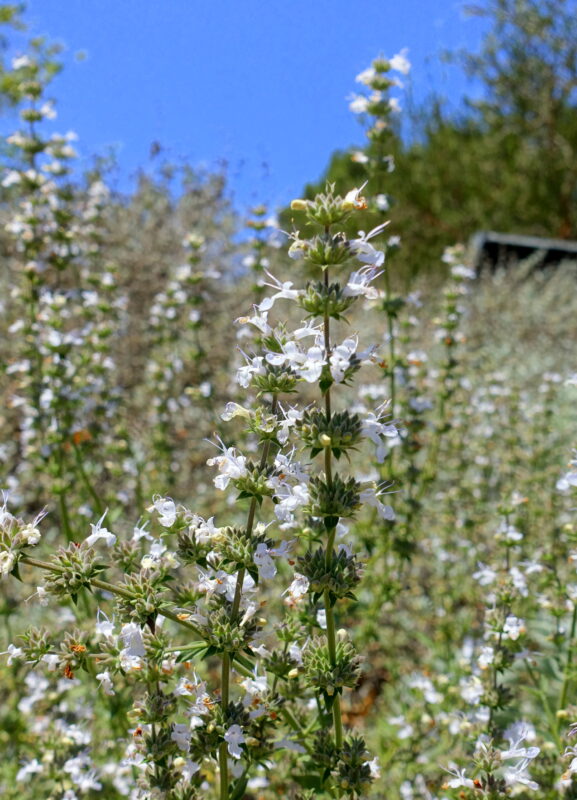
Salvia species, including varieties such as Salvia apiana, Salvia dorrii, Salvia mellifera, Salvia pachyphylla, and Salvia mohavensis, are cherished for their fragrant foliage and adaptability to arid conditions. Depending on the species, these shrubs can range significantly in height and spread, and they typically produce vibrant blue or purple flowers that attract pollinators, particularly bees and hummingbirds. Uniquely drought-resistant, these salvias require minimal maintenance and are invaluable in creating sustainable, low-water gardens that celebrate the beauty of the desert.
Sphaeralcea ambigua (Apricot Mallow)

Sphaeralcea ambigua, or Apricot Mallow, typically reaches heights of about 3 feet and spreads 3 feet wide. This perennial plant boasts attractive orange flowers in spring that draw in various pollinators. Apricot Mallow is particularly well-suited to dry conditions, making it an ideal choice for high desert gardens. Its long blooming season and drought tolerance make it a favorite among gardeners looking to bring color and life to arid landscapes.
Stanleya pinnata (Prince’s Plume)

Stanleya pinnata, known as Prince’s Plume, is a striking perennial that grows between 2 to 5 feet high and 2 feet wide. Its tall flower spikes adorned with yellow blossoms create a stunning focal point in any desert garden. This native plant is adapted to dry soils and full sun, making it well-suited for xeriscaping. Prince’s Plume attracts butterflies and bees, contributing to the vibrancy and ecological diversity necessary for healthy gardens.
Thalictrum fendleri (Meadow Rue)

CC CC0 1.0
Thalictrum fendleri, or Meadow Rue, is a delicate plant that reaches heights of 4 feet and spreads about 2 feet wide. Known for its soft, feathery foliage and small, white flowers, it performs well in dry shade conditions, making it a unique addition to a high desert garden. Meadow Rue is a hardy perennial that provides visual texture and interest while adapting well to arid environments.
Trichostema lanatum (Wooly Blue Curls)
Trichostema lanatum, known as Wooly Blue Curls, offers a charming, aromatic presence in the garden, typically reaching heights of 3 to 4 feet and spreading similarly. This perennial produces lovely, blue, curly flowers that bloom in spring and attract a variety of pollinators. Wooly Blue Curls is ideal for low-water gardens, thriving in well-drained soils and requiring no summer watering once established, making it a sustainable choice for gardeners seeking resilient species.
Yucca Species (Yucca brevifolia, Yucca schidigera, Yucca whipplei ssp. whipplei)

Yucca species, such as Yucca brevifolia (Joshua Tree), Yucca schidigera (Mojave Yucca), and Yucca whipplei ssp. whipplei (Chaparral Yucca), showcase striking architectural forms with varying sizes. These desert natives feature sharp, sword-like leaves and produce tall flower spikes adorned with white blooms. Known for their ability to thrive in harsh conditions, Yuccas are low-maintenance and well-suited for drought-tolerant landscaping. Their captivating structure and resilience make them indispensable in the high desert garden.
Grasses, Small Perennials, and Annuals for High Desert Gardens
The high desert can be a challenging environment for gardeners, yet it also offers opportunities to cultivate a vibrant collection of grasses, perennials, and annuals that thrive in arid conditions. By selecting the right plants, you can create a dynamic garden filled with color, texture, and ecological value. This post explores a range of suitable species, their characteristics, and how they can enhance your high desert landscape.
Achillea millefolium (Yarrow)
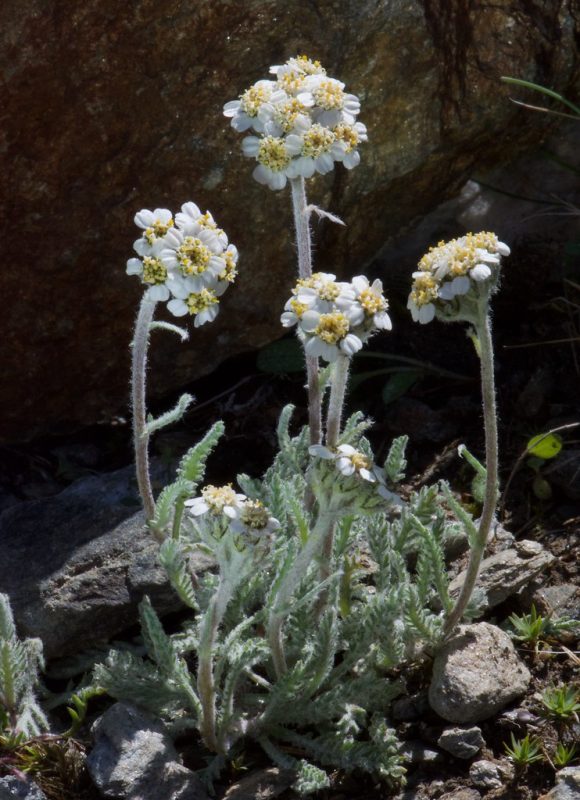
Yarrow, scientifically known as Achillea millefolium, is a versatile groundcover that reaches heights of about 18 inches and spreads 2 to 3 feet wide. This hardy plant does exceptionally well in partial sun, making it an ideal choice for gardens that receive dappled light. Yarrow is celebrated for its feathery foliage and clusters of tiny flowers that provide a lovely display from spring to early fall. Additionally, it attracts pollinators and beneficial insects, making it a valuable addition to any garden ecosystem.
Aquilegia formosa (Western Columbine)
The Western Columbine, or Aquilegia formosa, is a striking perennial that typically grows between 2 to 3 feet tall and 1 to 2 feet wide. Known for its showy, tubular flowers that bloom in shades of red and yellow, this plant is perfect for adding vibrant color to partially shaded areas of the garden. Western Columbine not only attracts hummingbirds but also offers a dramatic presence among other perennials and shrubs, making it a stunning focal point worthy of attention.
Asclepias californica and Asclepias eriocarpa (Milkweed)

Milkweed species, such as Asclepias californica and Asclepias eriocarpa, are essential for promoting biodiversity, particularly for Monarch butterflies. These perennials, which can reach varying heights, serve as host plants for these iconic butterflies and provide nectar for various pollinators during blooming months. Milkweeds prefer sunny locations and well-drained soils, flourishing in high desert landscapes while contributing to the ecosystem’s health and vibrancy.
Atriplex hymenelytra (Desert Holly)

Atriplex hymenelytra, commonly known as Desert Holly, is a stunning desert native that grows to about 3 feet high and wide. This evergreen shrub features unique holly-like leaves that offer an attractive silver-grey hue, perfect for rock gardens or as a backdrop for vibrant flowering plants. Desert Holly is highly drought-tolerant and can thrive in poor soils, making it an invaluable selection for easy-care gardening while providing essential habitat for local wildlife.
Baileya multiradiata (Desert Marigold)

Baileya multiradiata, or Desert Marigold, is a cheerful and colorful native perennial that typically grows about 1 foot high and wide. This low-maintenance plant produces bright yellow flowers in abundance during the spring and summer months, adding instant vibrancy to your garden. Desert Marigold is well-adapted to hot, dry conditions and can thrive with minimal care, making it an excellent choice for gardeners looking to display cheerful blooms in arid environments.
Bouteloua gracilis (Blue Grama Grass)

Blue Grama Grass, known scientifically as Bouteloua gracilis, is a low-growing grass typically reaching only 6 inches in height and spreading approximately 1 foot wide. This native grass is an attractive alternative to traditional lawns and is particularly suited for xeriscaping. Its distinctive flower spikes add a lovely touch to the landscape, while its drought tolerance means it requires less water than conventional grasses, making it a responsible choice for eco-conscious gardeners.
Eschscholzia californica (California Poppy)

The California Poppy, or Eschscholzia californica, is a beautiful annual that brightens gardens with its vibrant orange and yellow flowers. This native wildflower typically blooms in the spring and early summer, adapting well to dry conditions and poor soils. Its cheerful blooms attract pollinators, adding life to garden spaces while being incredibly easy to grow. Sprinkle the seeds across sunny areas of the garden for a stunning burst of color that symbolizes the wild beauty of California.
Leptodactylon californicum (Prickly Phlox)

Leptodactylon californicum, commonly known as Prickly Phlox, typically reaches heights of 1 to 2 feet and can spread from 1 to 3 feet wide. This perennial is covered in pink flowers during the springtime, creating a lovely carpet of color in your garden. Prickly Phlox is well-suited to rocky or sandy soils and thrives in full sun, making it an excellent choice for adding soft hues to desert landscapes while requiring minimal care.
Linum lewisii (Blue Flax)
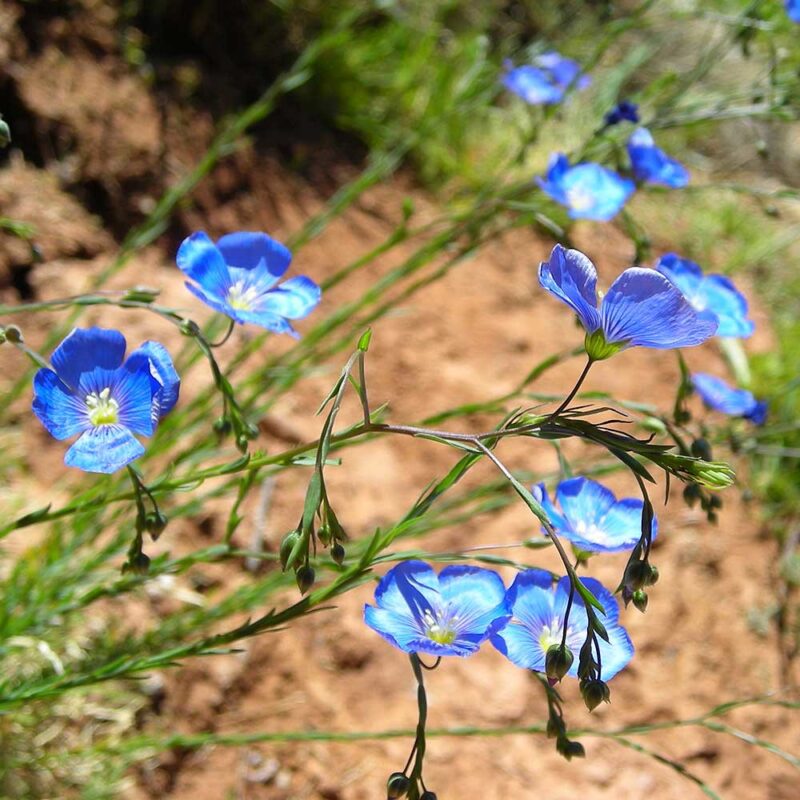
Linum lewisii, or Blue Flax, is a small perennial that typically grows to about 1 foot tall and spreads around 1 foot wide. Featuring delicate blue flowers that bloom in the spring, this graceful plant adds a touch of elegance to your high desert garden. Blue Flax thrives in sunny locations and well-drained soils, and its drought-tolerant nature ensures it remains an easy-care favorite for gardeners aiming to enhance their landscapes with low-water options.
Muhlenbergia rigens (Deergrass)
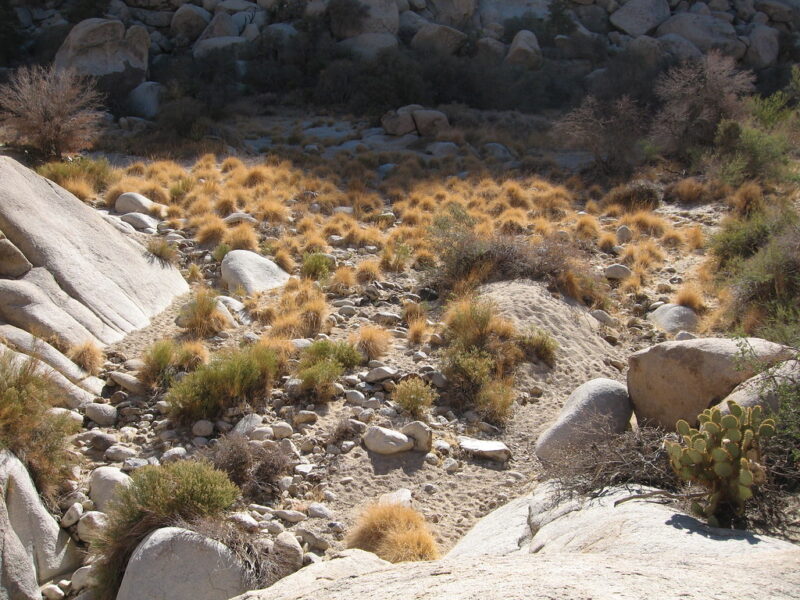
Muhlenbergia rigens, commonly known as Deergrass, is a stunning ornamental native grass that typically reaches heights of 4 feet and spreads about 4 feet wide. This grass adds lovely texture and movement to gardens, with its upright growth and feathery flower plumes that catch the breeze. Deergrass is adept at handling desert conditions and provides habitat for wildlife while enhancing the beauty of any landscape. Its drought resilience and elegant appearance make it a superior choice for high desert gardening.
Nassella cernua (Nodding Needlegrass)

Nassella cernua, or Nodding Needlegrass, is a delicate bunchgrass that grows to about 3 feet high and 3 feet wide. Known for its slender, graceful appearance, this grass is perfect for small spaces or rock gardens. Nodding Needlegrass thrives in well-drained soils and is drought-tolerant, making it an excellent option for low-water gardens. Its unique texture and form create visual interest and complement a variety of companion plants in desert landscapes.
Penstemon Species (Various Penstemons)

The various Penstemon species, including Penstemon eatonii, Penstemon pseudospectabilis, and Penstemon palmeri var. palmeri, are widely appreciated for their vibrant, colorful flowers. Depending on the species, they can grow in various heights but are typically seen with colorful red or purple blossoms that bloom in the spring. These hardy perennials are excellent choices for attracting hummingbirds and add vibrant hues to gardens, thriving in sunny locations with well-drained soils.
Salvia columbariae (Chia)

Chia, or Salvia columbariae, is an annual plant that flourishes in high desert conditions. Known for its vibrant purple flowers, this plant attracts pollinators during its blooming season. Chia is relatively easy to grow and establishes itself quickly in sunny areas, adding much-needed color and supporting local wildlife. It is often sown in wildflower meadows or mixed border gardens, offering an attractive landscape element with minimal care.
Sporobolus airoides (Alkali Sacaton)

Sporobolus airoides, or Alkali Sacaton, is an attractive and underappreciated native bunchgrass that typically grows to about 2 feet high and spreads to 3 feet wide. This grass thrives in alkaline or saline conditions, making it a suitable choice for niche areas of the garden. With delicate, airy flower heads, Alkali Sacaton adds a soft texture to the landscape and forms a valuable cover for wildlife. Its adaptability to challenging soil conditions enhances the diversity of your desert garden.
Verbena gooddingii (Gooding’s Verbena)

Gooding’s Verbena, or Verbena gooddingii, reaches heights of 1 foot and can spread between 1 to 2 feet wide. This charming perennial produces lavender flowers that bloom throughout the warmer months, attracting butterflies and bees. Gooding’s Verbena thrives in sunny locations and well-drained soils, proving to be a hardy option for high desert gardens. Its ability to attract pollinators makes it a beautiful addition to any ecosystem-focused landscape.
Conclusion
In the high desert, selecting the right grasses, small perennials, and annuals can create a stunning and resilient garden. The plants highlighted in this post offer a diverse range of colors, textures, and ecological benefits, making them excellent choices for sustainable landscaping. By incorporating these species into your garden design, you can cultivate an environment that not only thrives in arid conditions but also supports biodiversity and adds extraordinary beauty to the picturesque high desert landscape.




